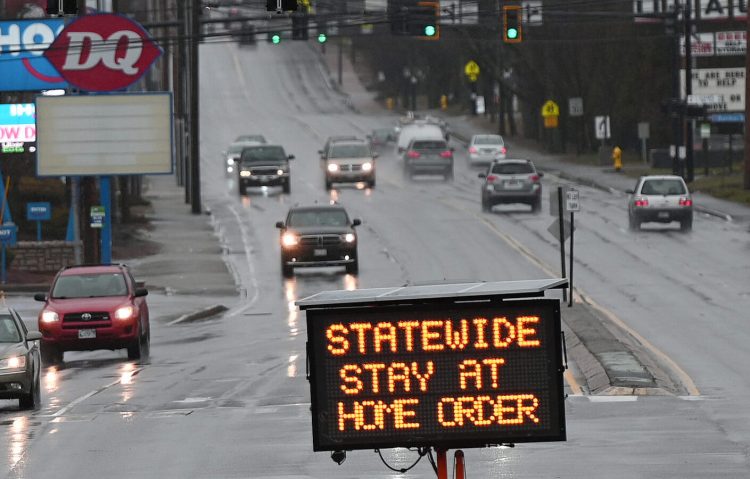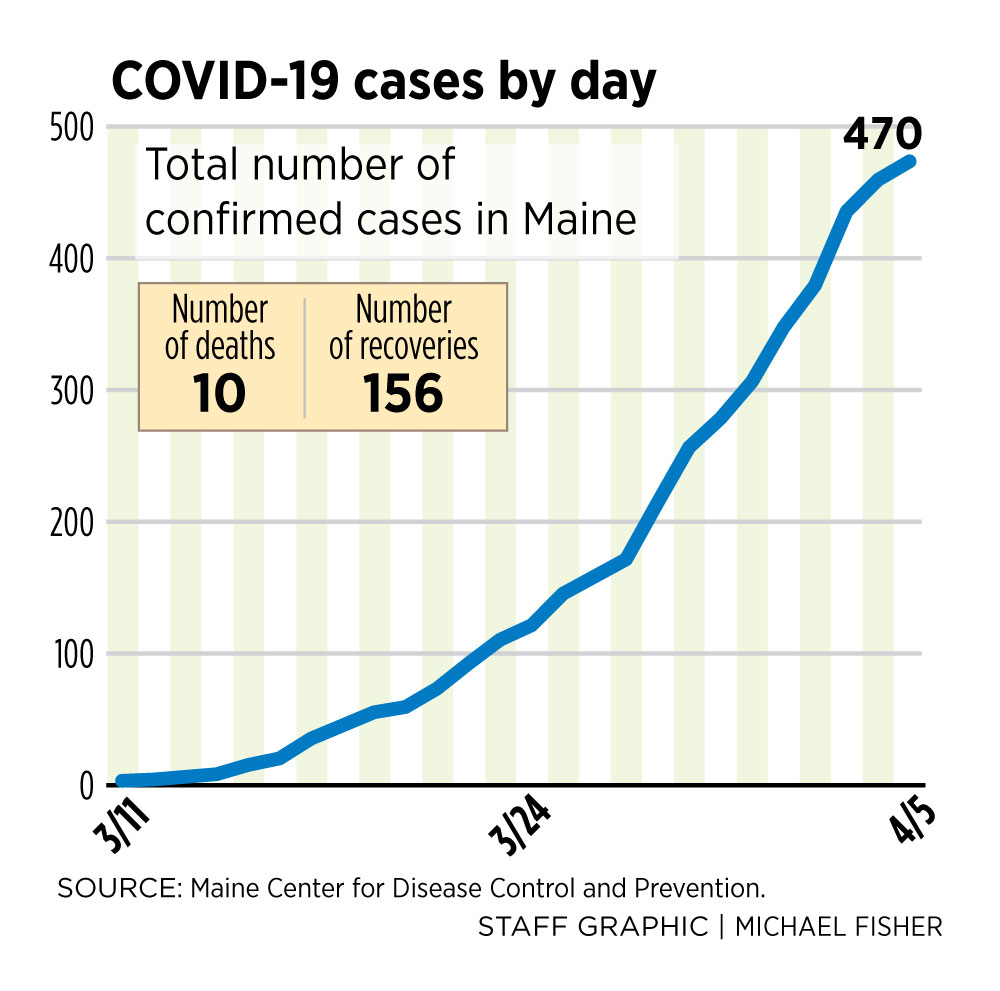The Maine Center for Disease Control and Prevention announced 14 new cases of the novel coronavirus on Sunday, for a total of 470 confirmed cases. There were no new deaths.
Meanwhile, the state released new details about how funds can be used under the federal disaster declaration for Maine approved by President Trump on Saturday.
As of Sunday morning, COVID-19, the illness caused by the coronavirus, had reached every Maine county but Piscataquis, the least populated. Cumberland County had 238 cases, and York County had 101, with both areas showing signs of community transmission.
Elsewhere, there were 20 cases in Androscoggin County, one in Aroostook, four in Franklin, two in Hancock, 22 in Kennebec, nine in Knox, eight in Lincoln, 11 in Oxford, 22 in Penobscot, 13 in Sagadahoc, four in Somerset, three in Waldo and one in Washington.
Eleven cases are listed as “unknown” in geographic origin, meaning that health investigators have not yet extensively interviewed the patients – not that authorities don’t know who they are.
The virus continues to have a diverse impact by age and sex, infecting a roughly equal number of males and females, according to Maine CDC statistics.
As of Sunday, a little over 2 percent of patients were under 20, while 9.1 percent were in their 20s, 8.5 percent were in their 30s, 17 percent were in their 40s, 19.8 percent were in their 50s, 21.5 percent were in their 60s, 13.6 percent were in their 70s, and 8.1 percent were 80 or older.
The disaster declaration for Maine will free up federal aid to state agencies, municipalities and tribes to defray the cost of fighting the coronavirus.
The Federal Emergency Management Agency says it will reimburse up to 75 percent of “approved” costs for public services used in the pandemic response, according to Gov. Janet Mills.
Sadly, we are also reporting a 10th death–a gentleman in his 70s from York Co with #coronavirus. Times like this are hard and I ask everyone to take time to #takecare.
— Nirav D. Shah (@nirav_uscdc) April 4, 2020
The state will kick in another 15 percent, and eligible applicants – including all state agencies, local governments and recognized American Indian tribes – will be responsible for the remaining 10 percent of costs. Those costs could include acquiring protective equipment, providing security or law enforcement, and running emergency operations centers or alternate care sites, a spokeswoman for the Maine Emergency Management Agency said Sunday.
On a case-by-case basis, the disaster declaration could pay for overtime for medical workers, provided that they were responding directly to coronavirus cases, said the spokeswoman, Susan Faloon. Applicants for disaster reimbursements must fill out a formal request with FEMA for costs over $3,300. Individuals cannot receive the aid.
Some private nonprofits may also be eligible for federal disaster money, Faloon said, if they provide critical services such as education, medical care, custodial care, emergency services and utilities. Other kinds of privately organized public service organizations could be eligible, too, including museums, community centers, libraries, homeless shelters, senior centers, and health and safety service providers.
Although applicants in other disaster scenarios sometimes can receive approval quickly, requests for coronavirus aid may take longer, Faloon said.
“In this unprecedented case, it is expected to take place over several months as COVID-19 emergency protective measures and associated costs are expected to continue,” she said in an email.
So far, the declaration does not cover child care, crisis counseling, disaster legal aid and other nongovernmental services for which Mills requested funding in a letter to Trump last Tuesday. Those requests are still under review, along with possible funding for the Maine National Guard, should it be needed to help control the outbreak.
Maine’s 10th death from the pandemic was confirmed on Saturday – a man in his 70s from York County, health officials said.
Eighty-six Mainers have been hospitalized and 156 have recovered during the course of the outbreak.
With 56 new cases, Friday marked Maine’s largest single-day rise of COVID-19 since March 12, the date of the first diagnosed case in the state. But public health officials warn that one day’s increase in cases isn’t helpful in measuring the overall progress of an outbreak – it’s better to track those numbers over weeks or longer.
The Maine CDC also is no longer reporting total numbers of tests day by day, making it difficult to put into context the rising number of positive results. Officials at the public health agency say the number of outside labs testing samples in Maine makes it too hard to regularly track how many tests are negative. The latest available number is 8,411 negative tests, from April 1, said Maine CDC spokesman Robert Long.
Still, the daily increases in cases are “in line with our region,” Dr. Nirav Shah, director of the Maine CDC, said on Friday.
Shah and his colleagues are urging Mainers to act as though the virus is in their communities, even if there are few or no confirmed cases.
In an executive order last week, Mills added some weight to that recommendation. She issued a statewide “stay-at-home” order, effective until at least April 30, that also requires that out-of-state visitors self-quarantine for at least 14 days.
Businesses providing temporary lodging – such as hotels – also were ordered to suspend operations, with exceptions that allow them to put up health care workers and the homeless.
That part of the order sent hospitality businesses scrambling to redo their schedules and account for a hit to their income, though owners and industry leaders said they understood why the restrictions were necessary for public health.
Mills’ order also frees up access to state aid that helps Mainers meet such basic needs as groceries and rent.
The General Assistance program, which provides vouchers for basic goods and services, will process all applications as emergency applications. Beneficiaries of the program will receive services for 60 days, rather than 30, before having to reapply.
The Maine Department of Health and Human Services will also provide an emergency $11.5 million in benefits for the Supplemental Nutrition Assistance Program in April, and increase food benefits through Temporary Assistance for Needy Families program from $50 to $100 from March through July.
Public health officials also are asking the federal government for help, especially when it comes to personal protective equipment – or PPE – for medical workers.
The Maine CDC supplies health workers around the state with equipment, and Shah said on Friday that his agency and the Maine Department of Transportation were distributing over 109,000 pieces of PPE. That includes more than 8,400 N95 masks; over 40,000 surgical masks; nearly 2,000 disposable protective suits; 33,000 gloves; almost 16,000 face shields; and more than 10,000 surgical gowns.
Maine health officials are gauging the need for PPE and other supplies by creating projections of what the outbreak might look like in coming weeks. They have declined to share those projections with the public, however.
The Maine CDC also tracks the state’s medical readiness in terms of intensive care unit beds and ventilators, the devices that help patients with aggressive cases to breathe. As of Sunday morning, Maine had 299 total ICU beds and 139 were available; there were 324 ventilators, of which 274 were available.
The state also had 197 alternative ventilators approved by the U.S. Food and Drug Administration. The Maine CDC doesn’t break down how many are available versus in use.
Testing for COVID-19 is key to containing the pandemic, but state health officials said they needed more supplies to keep up. Until more tests are available, the true number of COVID-19 cases is likely to be undercounted, they say.
Although help may be coming in the form of a new, fast test, designed and produced in Maine by Abbott Laboratories, the Maine CDC said on Saturday that it hadn’t yet received those kits.
Send questions/comments to the editors.




Comments are no longer available on this story